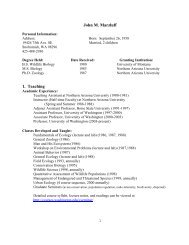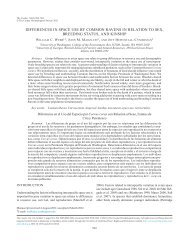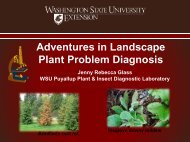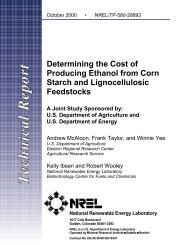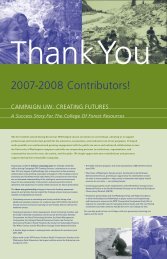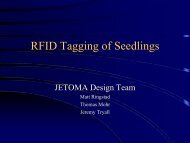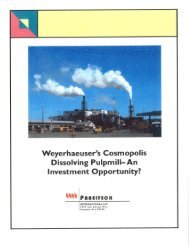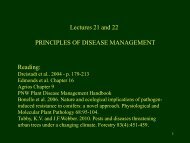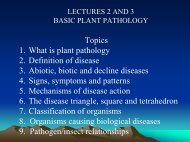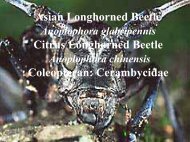Human Domination of Earth's Ecosystems - School of Environmental ...
Human Domination of Earth's Ecosystems - School of Environmental ...
Human Domination of Earth's Ecosystems - School of Environmental ...
You also want an ePaper? Increase the reach of your titles
YUMPU automatically turns print PDFs into web optimized ePapers that Google loves.
ants and even aerosol propellants. The subsequentdiscovery that CFCs drive thebreakdown <strong>of</strong> stratospheric ozone, and especiallythe later discovery <strong>of</strong> the Antarcticozone hole and their role in it, representgreat surprises in global environmental science(37). Moreover, the response <strong>of</strong> theinternational political system to those discoveriesis the best extant illustration thatglobal environmental change can be dealtwith effectively (38).Particular compounds that pose serioushealth and environmental threats can beand <strong>of</strong>ten have been phased out (althoughPCB production is growing in Asia). Nonetheless,each year the chemical industryproduces more than 100 million tons <strong>of</strong>organic chemicals representing some 70,000different compounds, with about 1000 newones being added annually (39). Only asmall fraction <strong>of</strong> the many chemicals producedand released into the environmentare tested adequately for health hazards orenvironmental impact (40).Biotic Changes<strong>Human</strong> modification <strong>of</strong> Earth’s biologicalresources—its species and genetically distinctpopulations—is substantial and growing.Extinction is a natural process, but thecurrent rate <strong>of</strong> loss <strong>of</strong> genetic variability, <strong>of</strong>populations, and <strong>of</strong> species is far abovebackground rates; it is ongoing; and it representsa wholly irreversible global change.At the same time, human transport <strong>of</strong> speciesaround Earth is homogenizing Earth’sbiota, introducing many species into newareas where they can disrupt both naturaland human systems.Losses. Rates <strong>of</strong> extinction are difficultto determine globally, in part because themajority <strong>of</strong> species on Earth have not yetbeen identified. Nevertheless, recent calculationssuggest that rates <strong>of</strong> species extinctionare now on the order <strong>of</strong> 100 to 1000times those before humanity’s dominance <strong>of</strong>Earth (41). For particular well-knowngroups, rates <strong>of</strong> loss are even greater; asmany as one-quarter <strong>of</strong> Earth’s bird specieshave been driven to extinction by humanactivities over the past two millennia,particularly on oceanic islands (42) (Fig. 2).At present, 11% <strong>of</strong> the remaining birds,18% <strong>of</strong> the mammals, 5% <strong>of</strong> fish, and 8% <strong>of</strong>plant species on Earth are threatened withextinction (43). There has been a disproportionateloss <strong>of</strong> large mammal speciesbecause <strong>of</strong> hunting; these species played adominant role in many ecosystems, andtheir loss has resulted in a fundamentalchange in the dynamics <strong>of</strong> those systems(44), one that could lead to further extinctions.The largest organisms in marinesystems have been affected similarly, byfishing and whaling. Land transformation isthe single most important cause <strong>of</strong> extinction,and current rates <strong>of</strong> land transformationeventually will drive manymore species to extinction, although witha time lag that masks the true dimensions<strong>of</strong> the crisis (45). Moreover, the effects <strong>of</strong>other components <strong>of</strong> global environmentalchange—<strong>of</strong> altered carbon and nitrogencycles, and <strong>of</strong> anthropogenic climatechange—are just beginning.As high as they are, these losses <strong>of</strong> speciesunderstate the magnitude <strong>of</strong> loss <strong>of</strong>genetic variation. The loss to land transformation<strong>of</strong> locally adapted populations withinspecies, and <strong>of</strong> genetic material withinpopulations, is a human-caused change thatreduces the resilience <strong>of</strong> species and ecosystemswhile precluding human use <strong>of</strong> thelibrary <strong>of</strong> natural products and genetic materialthat they represent (46).Although conservation efforts focusedon individual endangered species haveyielded some successes, they are expensive—andthe protection or restoration <strong>of</strong>whole ecosystems <strong>of</strong>ten represents the mosteffective way to sustain genetic, population,and species diversity. Moreover, ecosystemsthemselves may play important roles inboth natural and human-dominated landscapes.For example, mangrove ecosystemsprotect coastal areas from erosion and providenurseries for <strong>of</strong>fshore fisheries, but theyare threatened by land transformation inmany areas.Invasions. In addition to extinction, humanityhas caused a rearrangement <strong>of</strong>Earth’s biotic systems, through the mixing<strong>of</strong> floras and faunas that had long beenisolated geographically. The magnitude <strong>of</strong>transport <strong>of</strong> species, termed “biological invasion,”is enormous (47); invading speciesare present almost everywhere. On manyislands, more than half <strong>of</strong> the plant speciesare nonindigenous, and in many continentalareas the figure is 20% or more (48) (Fig.2).As with extinction, biological invasionoccurs naturally—and as with extinction,human activity has accelerated its rate byorders <strong>of</strong> magnitude. Land transformationinteracts strongly with biological invasion,in that human-altered ecosystems generallyprovide the primary foci for invasions, whilein some cases land transformation itself isdriven by biological invasions (49). Internationalcommerce is also a primary cause<strong>of</strong> the breakdown <strong>of</strong> biogeographic barriers;trade in live organisms is massive and global,and many other organisms are inadvertentlytaken along for the ride. In freshwatersystems, the combination <strong>of</strong> upstreamland transformation, altered hydrology, andnumerous deliberate and accidental speciesintroductions has led to particularly widespreadinvasion, in continental as well asisland ecosystems (50).In some regions, invasions are becomingmore frequent. For example, in the SanFrancisco Bay <strong>of</strong> California, an average <strong>of</strong>one new species has been established every36 weeks since 1850, every 24 weeks since1970, and every 12 weeks for the last decade(51). Some introduced species quickly becomeinvasive over large areas (for example,the Asian clam in the San Francisco Bay),whereas others become widespread only aftera lag <strong>of</strong> decades, or even over a century(52).Many biological invasions are effectivelyirreversible; once replicating biological materialis released into the environment andbecomes successful there, calling it back isdifficult and expensive at best. Moreover,some species introductions have consequences.Some degrade human health andthat <strong>of</strong> other species; after all, most infectiousdiseases are invaders over most <strong>of</strong> theirrange. Others have caused economic lossesamounting to billions <strong>of</strong> dollars; the recentinvasion <strong>of</strong> North America by the zebramussel is a well-publicized example. Somedisrupt ecosystem processes, altering thestructure and functioning <strong>of</strong> whole ecosystems.Finally, some invasions drive losses inthe biological diversity <strong>of</strong> native species andpopulations; after land transformation, theyare the next most important cause <strong>of</strong> extinction(53).ConclusionsThe global consequences <strong>of</strong> human activityare not something to face in the future—asFig. 2 illustrates, they are with us now. All<strong>of</strong> these changes are ongoing, and in manycases accelerating; many <strong>of</strong> them were entrainedlong before their importance wasrecognized. Moreover, all <strong>of</strong> these seeminglydisparate phenomena trace to a singlecause—the growing scale <strong>of</strong> the human enterprise.The rates, scales, kinds, and combinations<strong>of</strong> changes occurring now are fundamentallydifferent from those at any othertime in history; we are changing Earthmore rapidly than we are understanding it.We live on a human-dominated planet—and the momentum <strong>of</strong> human populationgrowth, together with the imperative forfurther economic development in most <strong>of</strong>the world, ensures that our dominance willincrease.The papers in this special section summarizeour knowledge <strong>of</strong> and provide specificpolicy recommendations concerningmajor human-dominated ecosystems. In addition,we suggest that the rate and extent<strong>of</strong> human alteration <strong>of</strong> Earth should affecthow we think about Earth. It is clear thatwe control much <strong>of</strong> Earth, and that ourDownloaded from www.sciencemag.org on September 17, 2012498SCIENCE VOL. 277 25 JULY 1997 www.sciencemag.org



